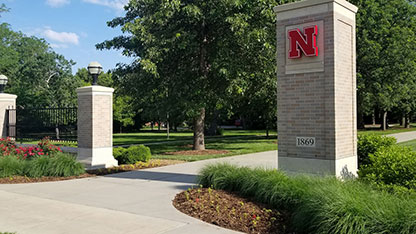![]()

By Anita Gall, Nebraska Extension Master Gardener
Pine Tree Needles
Have you noticed the needles changing color on your pine trees? Is it the inner needles only? Evergreens don’t keep their needles indefinitely but will typically drop the inner needles in September or October depending upon the year. Needle drop is a natural occurrence and is not harmful to the tree, in fact it is the way the tree feeds itself in the forest. As the needles decompose it creates a rich organic matter in the ground beneath the tree supplying it with nutrients.
Root Growth
Did you know that one of the biggest root growth periods is in the fall for trees and shrubs? As the ambient and ground temperatures begin to drop in the fall it signals the plant that it is time to begin shutting down and prepare for winter. It is important for this root growth to have adequate water, meaning that we should continue to water our trees until the ground freezes. Having sufficient ground moisture is imperative for the winter survival of plants.
Watering Trees in Winter
Since winter watering of trees is important the next question is how often? Watering in our area is especially important as we continue in a drought cycle. The water that a tree gets from a lawn sprinkler is not sufficient for root growth. A good deep watering is needed at least once a month, even in winter. Use the holidays as a reminder to water your trees; enjoy Thanksgiving, water your trees, enjoy Christmas, water your trees, January warmup, water your trees.
Overwatering Your Lawn
Watering your lawn is important to the appearance and health but overwatering can be as bad as not enough water. If you are seeing mushrooms in your lawn, more than likely you are overwatering. As we are cooling down for fall, one inch of water applied to the lawn per week in October should be sufficient. It is better to water less often but for a longer period of time. Place tuna cans in your lawn to measure how much water is being applied during each application of water.
Don’t Prune in the Winter
As we enter into the fall it is the close of another growing season. The cooler temperatures make us want to get out into our yards and prepare for winter. Pruning is one chore that should not be done in the fall for it creates an injury and the tree is not focused on producing tissue that will seal the injury. Also pruning can stimulate new growth which then would be susceptible to freeze damage. Fall pruning is best focused on the removal of dead, dying, broken or hazardous limbs.
More Master Gardner tips available at https://ianrnews.unl.edu/written-by/nebraska-extension-master-gardener
